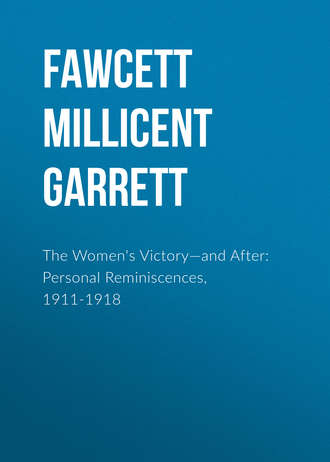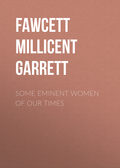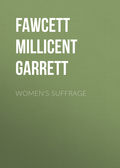
Fawcett Millicent Garrett
The Women's Victory—and After: Personal Reminiscences, 1911-1918
Nevertheless, when we remember that between 1902 and 1914 only two really important Acts bearing specially upon the welfare and status of women had been passed – namely, the Midwives Act, 1902, and the group of Acts, dating from 1907 to 1914, dealing with the qualification of women as candidates in local elections – and that since the passing of the Reform Act of 1918 at least seven important measures effecting large improvements in the status of women have rapidly gone through all their stages in both Houses of Parliament, we shall not be slow to appreciate the fact that the women's vote has made a very big difference indeed. The Act which rendered women eligible for Parliament, introduced in the Commons late in the autumn Session of 1918, went through both Houses in about a fortnight. In the Lords it was adopted without opposition.
Not of great importance in itself, but significant in its implications, was the quiet removal of the heavy grille of the Ladies' Gallery of the House of Commons in the summer of 1918, and the opening to women on equal terms of the Strangers' Gallery. Part of the grille has been preserved for the London Museum, and part will be kept in the House itself. It may be hoped that it will be put up in some appropriate place, with waxen dummies behind it revelling in the Oriental seclusion which recommended it to the Commons for about seventy years. One great discomfort of the grille was that the interstices of the heavy brass work were not large enough to allow the victims who sat behind it to focus it so that both eyes looked through the same hole. It was like using a gigantic pair of spectacles which did not fit, and made the Ladies' Gallery a grand place for getting headaches.
Suffragists are not labouring under the impression that because women now have votes no further reform is needed in our representative system. A large proportion of suffragists are probably in favour of proportional representation, and would favour its adoption mainly on the ground that it would secure a much fairer reflection of the whole nation than the present system, which may, and frequently does, result in the practical exclusion from representation of large masses of the voters. A good deal of education and spade work in spreading the principles of proportional representation are necessary on this and other important reforms, but now that women form a very considerable portion of the electorate they have at least the satisfaction of knowing that their views on this and other important political issues count for something, and are actually studied and considered, so that things work out much more rapidly than ever before in the direction they desire.
The enfranchisement of women, especially the immense addition to the women municipal electors, has put the position of women in local elections on quite a new footing. Formerly, when there were only about a million women voters on the municipal registers of the three kingdoms, and these, in considerable numbers, were either aged or on the brink of old age, they were a negligible quantity. They were neither admitted to the men's organizations nor consulted by them; the candidature of women for locally elected councils was cold-shouldered or opposed by all the party organizations; but the situation is quite different now. The women local electors have increased from one million to eight and a half millions, and, besides this, women are also parliamentary electors; the result is that all the parties encourage the candidature of women, and are pleased to have one or more women's names on their own tickets. Thus the number of women elected in the recent borough council elections in London bounded up on November 1st, 1919, to nearly two hundred. Chelsea, which never returned a woman before, now returns ten; Westminster returns seven; Marylebone returns four, and so on; and the results in many of the country towns were equally remarkable. (See the Common Cause, November 7th, 1919.)
Some time ago, in one of my controversies with Mrs. Humphry Ward, she lamented the very small number of women offering themselves as candidates in local government elections. I pointed out that the qualification for candidature was such as to exclude, in a large degree, the mass of the younger and more vigorous women; also, that the small number of women holding the local government franchise, coupled with the fact that they had no parliamentary vote, rendered them negligible from the party point of view, and I suggested to Mrs. Ward that the best way of increasing the number and improving the status of women concerned in local government would be to secure the abolition of their political disabilities. Events since February, 1918, have more than justified my argument.
Besides the positive gains to women and to the whole country which women's suffrage has brought about, it satisfactory to note that none of the disasters so freely prophesied by the antisuffragists have materialized. The prophets themselves seem to recognize that they were the baseless fabric of a vision now utterly vanished even from remembrance.
APPENDIX
A List of Acts of Parliament specially affecting the Welfare, Status, or Liberties of Women passed in the United Kingdom between 1902 and 1919 (both inclusive)
1902. The Midwives Act.– This Act aimed at securing for women in childbirth attended by midwives a reasonable security that these should have received a proper training. The Act was in many ways imperfect, but, such as it was, it took twelve years' hard and absorbing work from a group of able women to get it passed.
1905. Married Women's Property Amendment Act.– This Act rendered a married woman capable of disposing of a trust estate without her husband, as if she were a femme sole.
1907. Qualification of Women (County and Borough Councils) Act.– A similar Act was passed for Scotland in the same year, and for Ireland, with modifications, in 1911. These Acts removed the disqualification of sex and marriage, and rendered eligible on local councils married women living with their husbands, and daughters living with their parents. Fourteen years' strenuous work up to 1907 was necessary to secure their adoption. The necessary legislation was announced in the King's Speech as part of the Government programme of that year. It was the first time in the 700 years of British parliamentary history that an extension of the civil liberties of women had occupied such a position.
1914. County and Borough Councils Qualification Act, and similar Act for Scotland in the same year. These Acts provide for men and women alike a residential as distinct from the rate-paying qualification.
1914. Affiliation Orders Act sought to improve the position of the unmarried mother, but was very imperfect on account of its failure to provide any proper machinery for carrying it out.
1918. The Representation of the People Act (passed in February, 1918). – It placed nearly eight and a half million women upon the registers of voters in parliamentary elections. It also multiplied the number of women local government electors from one million to over eight and a half millions. It applies equally to every part of the United Kingdom.
1918. Eligibility of Women Act (November, 1918) rendered the election of women to the House of Commons a possibility. No work was required to get the Act passed. It was all but unopposed. Owing to the very short time between the passing of the Act and the General Election the opportunity for women to select constituencies and work up their candidature was very inadequate. Nevertheless, there were seventeen women candidates, one of whom, in Ireland, was elected.
1918. Affiliation Orders (Increase of Maximum Payment) Act, 1918, amends the Bastardy Laws Act of 1872, which fixed five shillings a week as the maximum which the father could be made to pay towards the maintenance of an illegitimate child, raising this sum to ten shillings a week.
1918. Midwives Amending Act, 1918, removes some of the weaknesses of the Act of 1902, and is sufficiently described in the foregoing chapter.
1919. Sex Disqualification Removal Act.– This Government Act has already been sufficiently described. The wider and more sweeping measure introduced by the Labour Party passed all its stages in the House of Commons, notwithstanding Government opposition.
1919. The Intestate Moveable Succession (Scotland) Act enlarges a Scottish mother's rights of succession to the intestate moveable estate of her children.
1919. Nurses' Registration Act, 1919. – Trained nurses without the vote had been working for registration for thirty-two years. The principle of registration was accepted by the Government, and the Act embodying it carried into law the year following the enfranchisement of women.
1919. The Industrial Courts Act was improved by the Government accepting the amendment of the Labour Party that one or more members of these courts should be women.
It will be seen from the foregoing survey of the legislative activity of Parliament in the eighteen years under review that they divide themselves into two unequal portions, 1902-1914 and 1918-1919. The war years are omitted for obvious reasons. In the first and longer period of fifteen years we find five measures of varying importance – that is, at the rate of one to every three years. By far the most important of these measures are the Midwives Act, 1902, and the series of Acts dealing with the qualifications of women for local government elections; both of these were due to years of hard work – twelve in one case, and fourteen in the other – of very active and efficient women's societies. In the second, and far shorter, period, of less than two years – February, 1918, to November, 1919 – we find seven Acts of value and importance slipping through Parliament without any trouble at all; ministerial swords leaping from their scabbards to remove impediments from the path of the free citizenship of women. This is the "difference" the vote has made.




